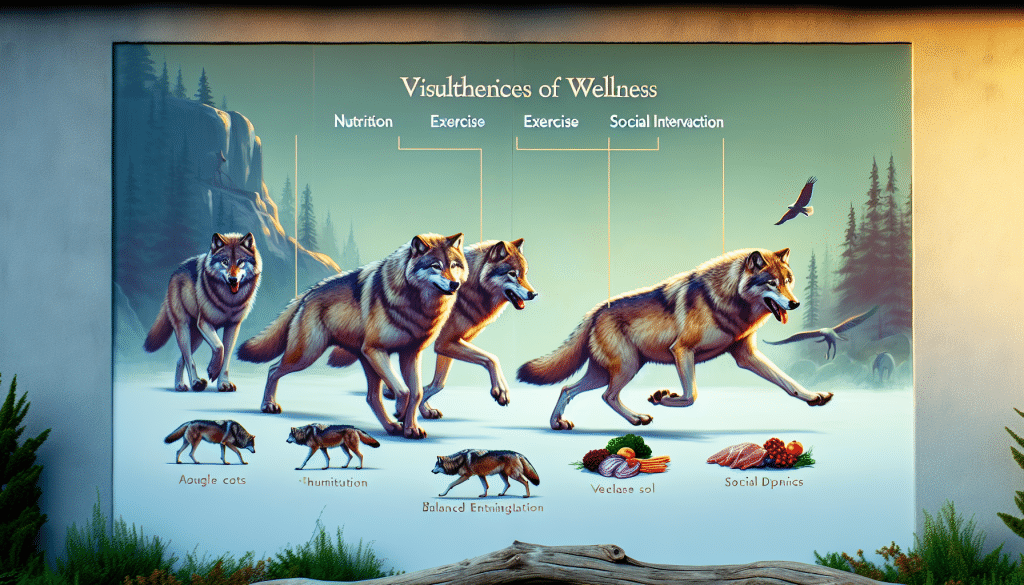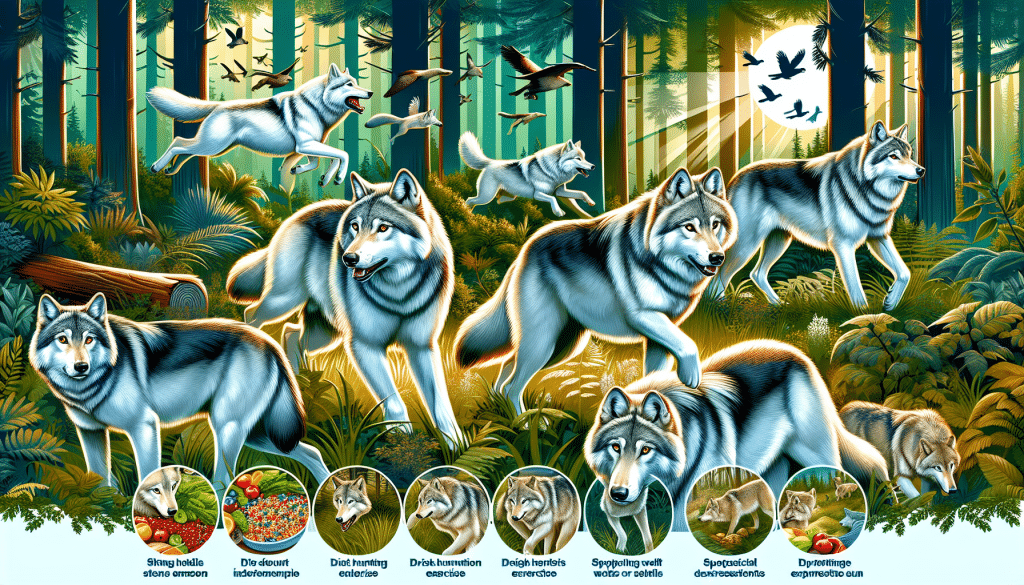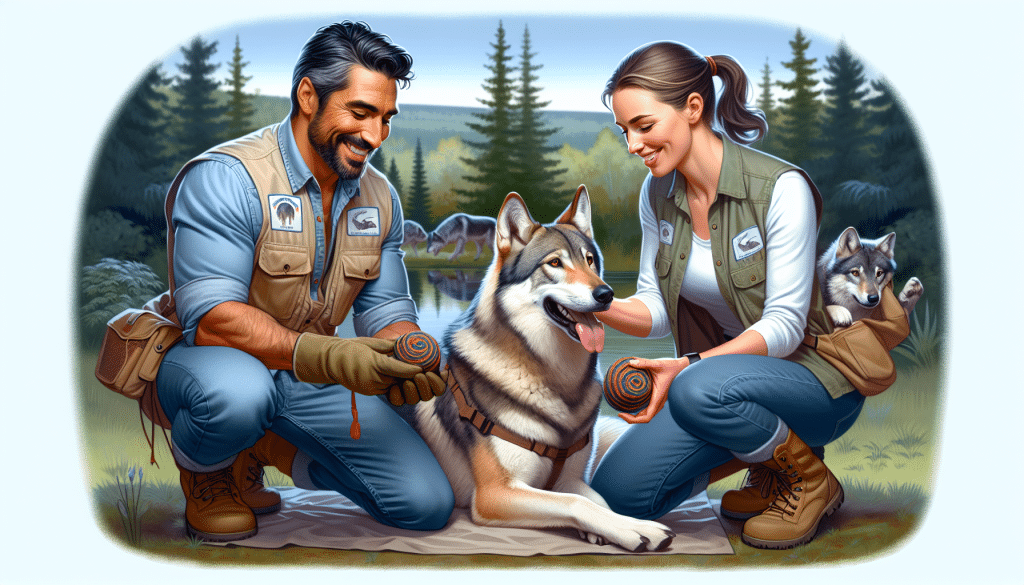You think it’s absurd that people don’t understand the significance of wolf health and wellness. These majestic creatures are an integral part of the ecosystem, and yet, their well-being is often overlooked or disregarded. It’s infuriating to see how their habitats are shrinking, their populations are diminishing, and their health is deteriorating. The importance of wolf health and wellness cannot be overstated, as it directly impacts the balance of nature and the survival of countless other species. It’s time to wake up and take action before it’s too late.

Understanding Wolf Biology
Physical Characteristics of Wolves
Wolves are majestic and powerful creatures, with a robust physique and a distinctive coat of fur. They typically have a stocky build, sturdy legs, and a strong, muscular body. Their fur can vary in color, ranging from shades of gray, black, and brown. With sharp, pointed ears and piercing eyes, wolves possess a striking appearance that demands respect.
The average size of wolves varies depending on the subspecies and geographical region. Adult males range from 80 to 150 pounds, while females are often slightly smaller, weighing between 50 and 100 pounds. These physical characteristics contribute to their agility and exceptional hunting abilities, enabling them to thrive in diverse environments.
Wolf Life Cycle: Pups to Alpha
Wolves live in complex social structures known as packs, led by an alpha male and an alpha female. The alpha pair is responsible for guiding the pack, making decisions, and ensuring the survival of their offspring. The life cycle of a wolf begins with a litter of pups born to the alpha female.
Wolf pups are incredibly vulnerable in their early stages, reliant on their parents and older siblings for survival. As they grow, they learn vital skills such as hunting, territory marking, and communication through howling. By the age of two or three years old, wolves reach sexual maturity, and some may disperse to find new territories and establish their own packs.
Dietary Requirements for Optimal Health
Wolves are carnivorous animals, primarily relying on a diet of large ungulates such as deer, elk, and moose. Their sharp teeth and strong jaws are well adapted for tearing flesh and consuming their prey. Consuming a high-protein diet is crucial for the wolves’ optimal health and overall well-being.
The ability to hunt and secure their food is an essential aspect of a wolf’s survival. By preying on herbivores, wolves play a vital role in regulating herbivore populations and maintaining a balanced ecosystem.
Common Health Issues in Wild and Captive Wolves
Wolves, like any other living beings, are susceptible to various health issues. The challenges they face can differ between wild and captive populations. In the wild, wolves may encounter injuries from hunting or defending their territories. Additionally, they may suffer from malnutrition during times of scarcity or be exposed to infectious diseases transmitted by other wildlife.
In captive settings, such as sanctuaries or reserves, wolves face different health concerns due to limited mobility and potential stressors from human interaction. Common issues in captive wolves include obesity, dental problems, and behavioral abnormalities resulting from the unnatural environment.
The Ecosystem Role of Healthy Wolves
Predation and Its Impact on Biodiversity
Wolves play a crucial role as apex predators in their ecosystems. By preying on herbivores, they help control and regulate populations, preventing overgrazing and habitat degradation. This predator-prey relationship is vital for maintaining a healthy balance within ecosystems, promoting biodiversity and supporting the overall health of the environment.
When wolves are absent or their populations decline, it can lead to an overabundance of herbivores, which can have a detrimental impact on vegetation and other wildlife species. The ripple effect of wolf predation cascades down through the food chain, influencing the abundance and behavior of various organisms.
Wolves in Trophic Cascades
Trophic cascades are powerful ecological phenomena in which changes in the population size of one species have far-reaching effects on the entire ecosystem. Wolves, as apex predators, can trigger trophic cascades by regulating herbivore populations.
For example, when wolves reduce the numbers of grazing animals such as elk, it allows vegetation to recover and thrive. Consequently, this increased vegetation provides habitat and food sources for smaller mammals, insects, and birds. The presence of wolves creates a domino effect, shaping the intricate web of life within an ecosystem.
Keystone Species: Balancing Populations
Wolves are considered “keystone species” due to their essential role in maintaining the structure and function of their ecosystems. As keystone species, their absence or decline can have far-reaching consequences, leading to imbalances in populations and disrupting the delicate equilibrium of nature.
By controlling populations of herbivores, wolves promote the health and diversity of plant species, maintain the availability of resources for other wildlife, and sustain the intricate web of interdependencies that shape ecosystems. The conservation of healthy wolf populations is therefore vital for the overall well-being of our natural world.

Wolf Health Monitoring
Field Research and Data Collection
Monitoring the health of wolf populations is crucial for understanding the threats they face and developing effective conservation strategies. Field research and data collection provide valuable insights into the overall well-being of wolves, including their reproductive success, disease prevalence, and population dynamics.
Researchers and conservationists employ various methods to study wolves in the wild, such as population surveys, tracking collars, and remote camera monitoring. By collecting data on individual wolves and their packs, scientists can better assess their health status and identify factors that may impact their long-term survival.
Disease Surveillance in Wolf Populations
Disease surveillance plays a vital role in understanding and managing the health risks to wild wolf populations. With increased interactions between wildlife, domestic animals, and humans, the spread of infectious diseases poses a significant threat to wolf populations worldwide.
In regions where wolves come into close contact with domestic dogs, diseases such as canine parvovirus and distemper can be particularly devastating. Surveillance programs help detect and monitor the spread of pathogens, allowing for early intervention and the implementation of appropriate disease prevention measures.
Use of Technology in Tracking Wolf Health
Advancements in technology have revolutionized the field of wildlife health monitoring, providing researchers with powerful tools to track and assess the well-being of wolf populations. GPS tracking collars equipped with health sensors allow for real-time data collection, providing valuable information on the wolves’ movements, behavior, and vital signs.
Furthermore, DNA analysis techniques enable scientists to study the genetic diversity of wolf populations, identifying potential inbreeding concerns that can impact health and long-term viability. These technological advancements enhance our understanding of wolf health, enabling targeted conservation efforts and informed decision-making.
Diseases and Parasites Affecting Wolves
Canine Parvovirus and Distemper in Wolves
Canine parvovirus and distemper are two significant infectious diseases that can devastate wolf populations. Canine parvovirus can cause severe gastrointestinal illness and can be transmitted through contact with infected feces or contaminated environments. Distemper, on the other hand, is a highly contagious disease that affects the respiratory, gastrointestinal, and nervous systems, often leading to death.
To prevent the spread of these diseases, vaccination programs and disease surveillance are of utmost importance. By vaccinating captive and vulnerable wild wolf populations, we can reduce the risk of outbreaks and protect the long-term health of these majestic creatures.
Managing Parasites: Ticks, Worms, and Mange
Parasites also pose a significant threat to wolf health. Ticks can transmit various blood-borne diseases, while worms can cause gastrointestinal issues and systemic infections. Mange, caused by parasitic mites, is a particularly troublesome condition that affects wolves, leading to fur loss, severe itchiness, and weakened immune systems.
Efforts to manage parasites require a multi-faceted approach, including regular veterinary care, monitoring, and strategic treatments to control infestations. Maintaining a healthy and parasite-free environment is crucial for ensuring the well-being and survival of wild and captive wolves alike.
Vaccination and Disease Prevention Strategies
Proactive vaccination and disease prevention strategies are key in safeguarding the health of wolf populations. Vaccination programs aimed at captive and reintroduced wolves can significantly reduce the risk of infectious disease outbreaks.
Additionally, public awareness campaigns and educational initiatives can promote responsible pet ownership, as spillover of diseases from domestic dogs to wild populations remains a significant concern. By addressing these preventive measures, we can mitigate the threats to wolf health and contribute to their long-term conservation.

Human Encroachment and Wolf Welfare
Habitat Loss and Fragmentation Effects
Human encroachment and habitat loss are major threats to wolves and their overall well-being. As human populations expand and their activities fragment natural habitats, wolves face shrinking territories and reduced access to resources. This habitat loss has detrimental effects on their ability to find suitable prey, establish territories, and maintain healthy populations.
Conserving and restoring wolf habitat is essential for ensuring their long-term survival. Efforts to protect and connect existing habitats through initiatives like wildlife corridors can help mitigate the negative impacts of habitat fragmentation, providing critical opportunities for wolves to thrive.
Human-Wildlife Conflict and Stress on Wolf Populations
Human-wildlife conflict poses significant challenges to wolf populations. Conflicts arise due to competition for resources, predation on livestock, and perceived threats to human safety. In response to these conflicts, wolves are often subjected to lethal control measures, leading to population declines and increased stress on surviving individuals.
Wolves in conflict-prone regions are more likely to experience stress-related behaviors, compromised immune systems, and decreased reproductive success. By adopting non-lethal measures, such as livestock protection programs and community engagement, we can foster coexistence between humans and wolves, ensuring their mutual well-being.
Conservation Efforts for Habitat Protection
Conservation organizations and government agencies play a crucial role in protecting and preserving wolf habitats. Through habitat protection and restoration initiatives, these organizations work to minimize human encroachment and ensure the availability of suitable habitats for wolf populations.
Collaborative efforts between stakeholders, including landowners, local communities, and conservationists, are vital for promoting effective conservation strategies. By addressing the root causes of conflicts and working towards shared goals, such as sustainable land-use practices and wildlife-friendly development, we can secure a better future for both wolves and humans.
The Role of Veterinary Care in Wolf Conservation
Providing Medical Care in Sanctuaries and Reserves
Veterinary care is essential for promoting the health and well-being of wolves in captive settings, such as sanctuaries and reserves. Trained veterinarians and animal caretakers play a critical role in monitoring the health of captive wolves, providing medical treatments, and ensuring optimal living conditions.
Regular check-ups, vaccinations, and preventive care are crucial components of effective veterinary programs. By addressing the unique challenges faced by captive wolves, veterinarians can help mitigate disease risks, reduce stress, and enhance the overall welfare of these magnificent animals.
Collaboration Between Wildlife Veterinarians and Conservationists
Collaboration between wildlife veterinarians and conservation organizations is paramount to successful wolf conservation. By combining their expertise and resources, these professionals can develop comprehensive health management plans, conduct research, and implement measures to protect and monitor wolf populations.
Wildlife veterinarians bring specialized knowledge of disease surveillance, anesthesia, and forensic investigations, while conservationists contribute ecological insights and expertise in habitat conservation. Together, they form a powerful alliance that supports the health and conservation of wolves.
Innovations in Non-Invasive Treatments
Advancements in veterinary medicine have led to innovative non-invasive treatments, benefiting both captive and wild wolf populations. Non-invasive techniques, such as remote delivery of medications and non-contact diagnostics, minimize the need for physical interventions, reducing stress and improving overall welfare.
Additionally, emerging technologies like telemedicine allow veterinarians to provide expert advice and consultation remotely. These non-invasive approaches not only improve the health outcomes of individual wolves but also contribute to the long-term conservation of the species by reducing the risks associated with physical interventions.
Wolf Reintroduction Programs
Historical Perspective on Wolf Reintroductions
Wolf reintroduction programs have been implemented worldwide to restore populations in regions where they have been extirpated or severely depleted. These programs aim to reestablish healthy and viable wolf populations, ultimately contributing to the ecological balance of these ecosystems.
Historical examples, such as the successful reintroduction of gray wolves to Yellowstone National Park in the United States, demonstrate the positive impacts such programs can have on ecosystems. By emulating these success stories, we can learn valuable lessons and apply them to future reintroduction efforts.
Monitoring Health in Reintroduced Populations
When reintroducing wolves to a previously inhabitable area, monitoring their health is of utmost importance. Reintroduced populations face unique challenges such as adapting to new environments, establishing territories, and encountering potentially unfamiliar diseases.
Monitoring programs in reintroduction areas focus on assessing the overall health of individuals, tracking disease prevalence, and identifying potential threats or risk factors. This allows conservationists to implement targeted management strategies and provide necessary medical interventions to ensure the long-term success of reintroduced wolf populations.
Success Stories and Lessons Learned
Wolf reintroduction efforts have yielded remarkable success stories, demonstrating the resilience and adaptability of these magnificent creatures. The reintroduction of wolves to Yellowstone National Park, for instance, had profound ecological impacts, including a reduction in overgrazing and habitat regeneration.
These success stories highlight the importance of understanding the complex dynamics between predators, prey, and ecosystems. Lessons learned from previous reintroduction programs emphasize the need for thorough planning, stakeholder engagement, and ongoing monitoring to ensure the long-term viability and health of reintroduced wolf populations.
Genetics and Wolf Population Health
Genetic Diversity and Inbreeding Concerns
Maintaining genetic diversity is crucial for the long-term health and viability of wolf populations. Inbreeding, which occurs when closely related individuals mate, can lead to a reduction in genetic diversity and increase the risk of genetic disorders, decreased fertility, and compromised immune systems.
Conservation efforts prioritize maintaining healthy levels of genetic diversity through strategies such as the introduction of new individuals from different populations and promoting dispersal within packs. By safeguarding genetic diversity, we can enhance the overall resilience of wolf populations and minimize the risks associated with inbreeding.
The Role of Genetics in Disease Resistance
Genetics plays a significant role in disease resistance among wolf populations. Variations in individual genes can influence resistance or susceptibility to infectious diseases, providing valuable insights into the potential health risks faced by specific populations.
Understanding the genetic basis of disease resistance can inform management decisions, such as identifying populations that may require targeted vaccination programs or implementing wildlife health interventions. By leveraging genetic research, conservationists can develop proactive strategies to protect vulnerable wolf populations and prevent disease outbreaks.
Conservation Genetics in Managing Wolf Populations
Conservation genetics is an essential tool in managing wolf populations. Genetic studies provide insights into population structure, connectivity, and the movement of individuals, helping to inform conservation decisions and prioritize areas for habitat protection.
Through genetic analysis, scientists can identify distinct populations, assess their genetic health, and identify potential areas of concern. By incorporating conservation genetics into management plans, we can ensure the long-term survival and genetic integrity of wolf populations, safeguarding their health and overall well-being.
Behavioral Aspects of Wolf Health
Stress Behaviors in Wolves
Wolves, like any social species, are sensitive to changes in their environment. Stress is a significant factor that can impact their overall health and well-being. Stress behaviors in wolves can manifest as increased aggression, abnormal reproductive patterns, and impaired immune function.
Understanding and mitigating stressors in wolf populations is essential for their long-term conservation. Efforts to reduce stress include providing adequate habitat, minimizing human disturbances, and implementing behavioral enrichment programs that enhance their natural behaviors and encourage mental stimulation.
Social Structure and Mental Well-being
Wolves are highly social animals, living in close-knit family units known as packs. The social structure within a pack is intricately linked to their mental well-being. Each individual has a specific role within the pack hierarchy, contributing to the overall stability and cohesion of the group.
Disruptions in social structure, such as the loss of an alpha individual, can lead to increased stress and behavioral issues within the pack. Conservationists and caretakers prioritize maintaining stable social structures and implementing appropriate interventions when necessary, ensuring the mental well-being of captive wolves.
Enrichment and Welfare in Captivity
Enrichment programs are essential for promoting the well-being of captive wolves. These programs aim to provide mental and physical stimulation that mimics the challenges and activities that wolves would encounter in the wild.
Enrichment activities can include providing puzzles, toys, and opportunities for social interaction within the pack. By stimulating natural behaviors and reducing stress, enrichment programs greatly contribute to the overall welfare of captive wolves, enhancing their physical and mental health.
The Future of Wolf Health and Conservation
Challenges and Opportunities Ahead
The future of wolf health and conservation is not without challenges. Rapid habitat loss, human-wildlife conflicts, and the potential impacts of climate change pose significant threats to wolf populations worldwide. Addressing these challenges requires a multifaceted approach that prioritizes habitat protection, mitigates conflicts, and safeguards genetic diversity.
However, alongside challenges, there are also opportunities for positive change. Advances in technology, increased public awareness, and international collaboration provide avenues for innovative conservation strategies. By leveraging these opportunities, we can ensure a brighter future for wolves, where their health and well-being are protected for generations to come.
Advancements in Conservation Technology
Advancements in conservation technology have the potential to revolutionize our efforts to protect wolf populations. From remote monitoring devices to genetic analysis techniques, these technologies enable more accurate and efficient data collection, improving our understanding of wolf health and population dynamics.
Furthermore, developments in non-invasive diagnostic techniques, such as DNA analysis from scat samples, provide valuable information without direct contact or disturbance to wild wolves. These technological advancements hold immense promise for enhancing our ability to monitor, conserve, and protect wolf populations.
International Collaboration for Wolf Preservation
The preservation of wolf populations requires global cooperation and collaboration. Wolves are not confined by geopolitical boundaries, and their conservation can only be achieved through collective efforts and joint initiatives.
International collaboration can involve knowledge sharing, mutual assistance in reintroduction programs, and coordinated research efforts. By pooling resources, expertise, and experiences, countries can work together to address common challenges and strengthen the global conservation network dedicated to wolf preservation.
In conclusion, understanding wolf biology is crucial for their conservation and overall well-being. By comprehensively exploring their physical characteristics, life cycle, dietary requirements, and common health issues, we gain valuable insights into the challenges they face. Recognizing the pivotal role of healthy wolves in maintaining ecosystem balance, monitoring their health, managing diseases and parasites, and addressing the impacts of human encroachment are essential steps towards their preservation. With the involvement of veterinary care, advancements in genetics, considerations of behavioral aspects, and reintroduction programs, we can pave the way for the future of wolf health and conservation. By embracing these opportunities and engaging in international collaborations, we can protect these iconic creatures and ensure their place in our natural world for generations to come.



